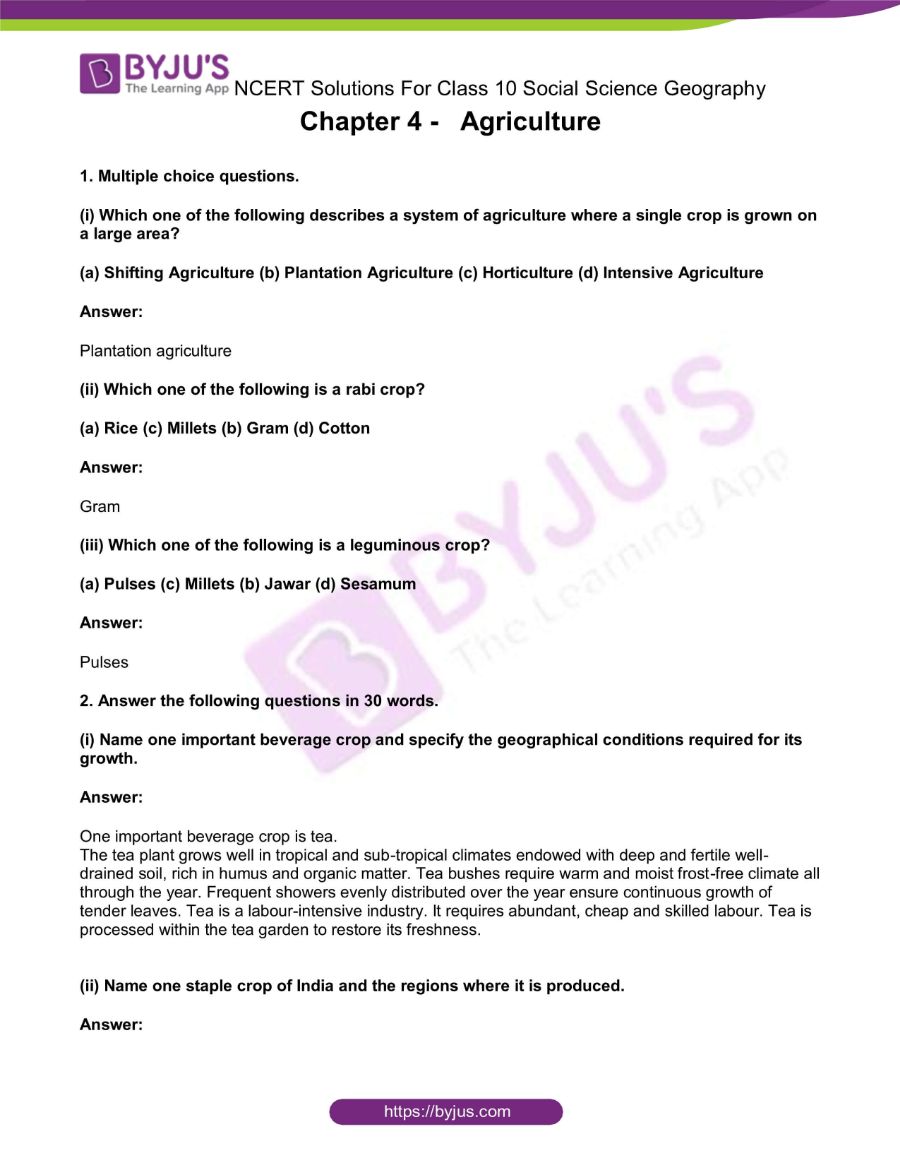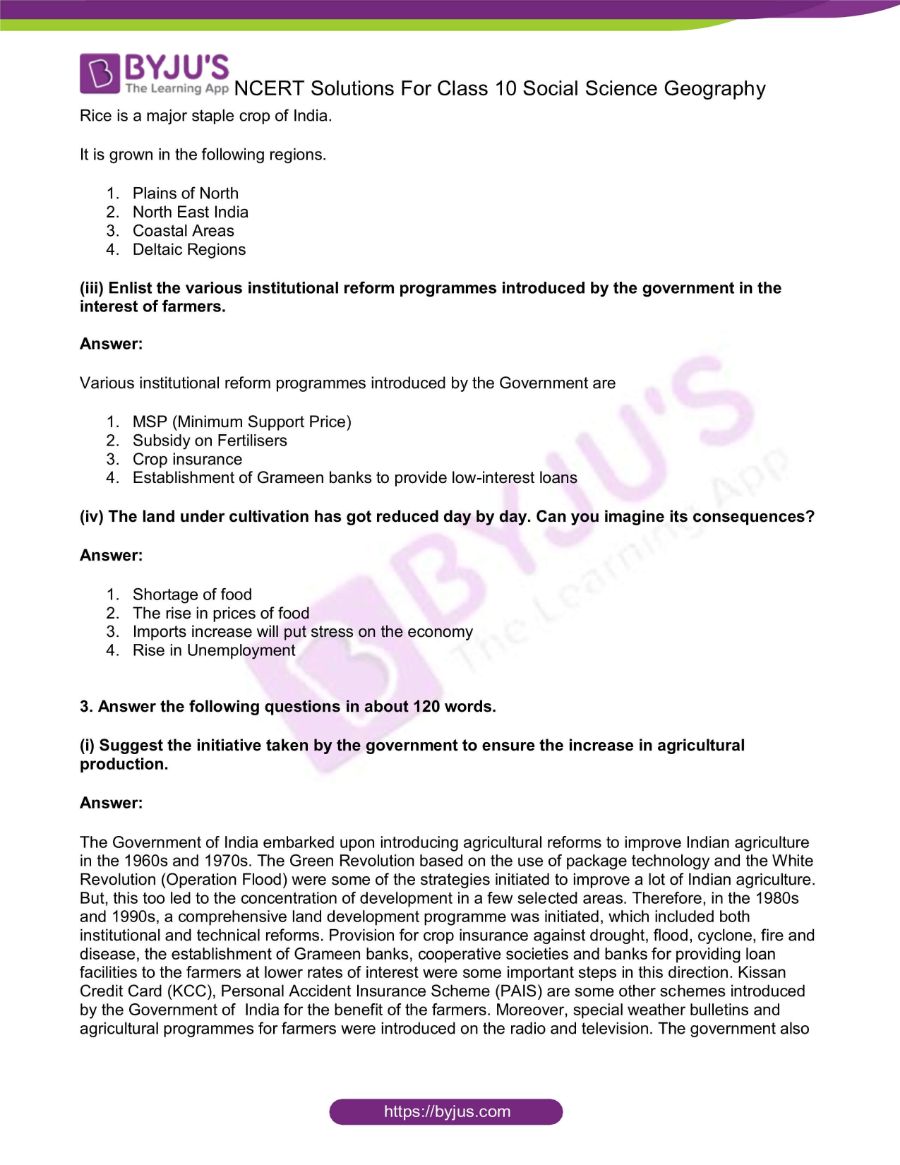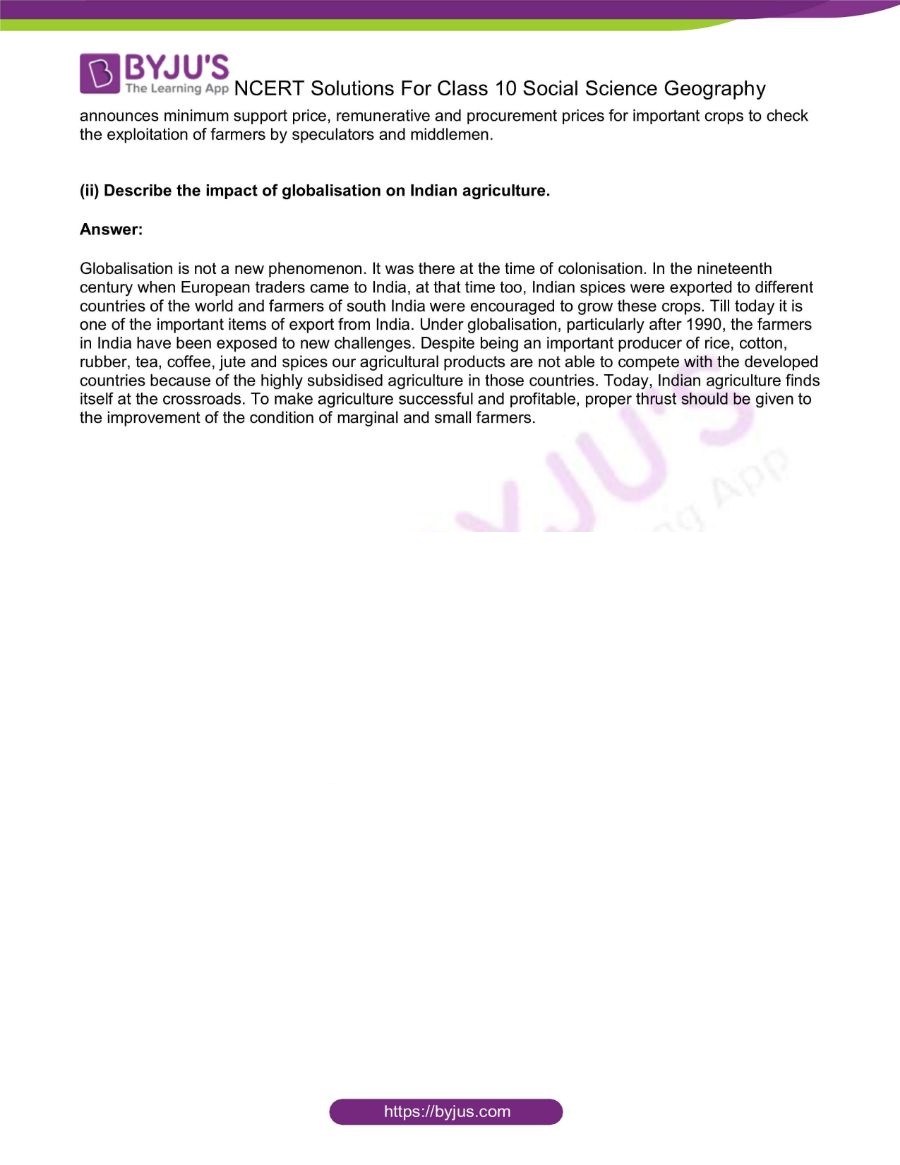NCERT Book Solutions for Class 10 Geography Contemporary India – II Chapter 4 Agriculture – CBSE Free PDF Download
NCERT Solutions for Class 10 Geography Chapter 4 Agriculture contains questions related to the various agricultural practices. The chapter is mainly based on topics such as types of farming, cropping pattern, the major crop produced in India, etc. Some of the questions are easy to answer, but sometimes students are not able to find the answers to some difficult questions. So, to help them, we have provided NCERT Solutions Class 10 Geography Social Science Chapter 4 Agriculture. The answers provided in these solutions will also give a better idea of writing the answers during the CBSE exam.
Students can download the NCERT Solutions for Class 10 Geography PDF below.
NCERT Solutions for Class 10 Geography (Contemporary India II) Chapter 4 – Agriculture
NCERT Solutions for Class 10 Geography Chapter 4 – Agriculture
The solutions for Chapter 4 of Agriculture are given below. Students should also check NCERT Solutions for Class 10 for other subjects.
Exercise Page No 46
1. Multiple choice questions.
(i) Which one of the following describes a system of agriculture where a single crop is grown in a large area?
(a) Shifting Agriculture (b) Plantation Agriculture (c) Horticulture (d) Intensive Agriculture
Answer:
Plantation agriculture
(ii) Which one of the following is a rabi crop?
(a) Rice (b) Millets (c) Gram (d) Cotton
Answer:
Gram
(iii) Which one of the following is a leguminous crop?
(a) Pulses (b) Millets (c) Jawar (d) Sesamum
Answer:
Pulses
2. Answer the following questions in 30 words.
(i) Name one important beverage crop and specify the geographical conditions required for its growth.
Answer:
One important beverage crop is tea.
The tea plant grows well in tropical and sub-tropical climates endowed with deep and fertile well-drained soil, rich in humus and organic matter. Tea bushes require warm and moist frost-free climate all through the year. Frequent showers evenly distributed over the year ensure continuous growth of tender leaves. Tea is a labour-intensive industry. It requires abundant, cheap and skilled labour. Tea is processed within the tea garden to ensure its freshness.
(ii) Name one staple crop of India and the regions where it is produced.
Answer:
Rice is a major staple crop of India.
It is grown in the following regions.
- Plains of North
- North East India
- Coastal Areas
- Deltaic Regions
(iii) Enlist the various institutional reform programmes introduced by the government in the interest of farmers.
Answer:
Various institutional reform programmes introduced by the Government are as follows:
- MSP (Minimum Support Price)
- Subsidy on fertilisers
- Crop insurance
- Establishment of Grameen banks to provide low-interest loans
(iv) The land under cultivation has got reduced day by day. Can you imagine its consequences?
Answer:
- Shortage of food
- The rise in prices of food
- Imports increase will put stress on the economy
- Rise in Unemployment
3. Answer the following questions in about 120 words.
(i) Suggest the initiative taken by the government to ensure the increase in agricultural production.
Answer:
The Government of India embarked on a mission to introduce agricultural reforms to improve Indian agriculture in the 1960s and 1970s. The Green Revolution based on the use of package technology and the White Revolution (Operation Flood) were some of the strategies initiated to improve a lot of Indian agriculture. But, this too led to the concentration of development in a few selected areas. Therefore, in the 1980s and 1990s, a comprehensive land development programme was initiated, which included both institutional and technical reforms. Provision for crop insurance against drought, flood, cyclone, fire and disease, the establishment of Grameen banks, cooperative societies and banks for providing loan facilities to the farmers at lower rates of interest were some important steps in this direction. Kissan Credit Card (KCC) and Personal Accident Insurance Scheme (PAIS) are some other schemes introduced by the Government of India for the benefit of the farmers. Moreover, special weather bulletins and agricultural programmes for farmers were introduced on the radio and television. The government also announces minimum support price, remunerative and procurement prices for important crops to check the exploitation of farmers by speculators and middlemen.
(ii) Describe the impact of globalisation on Indian agriculture.
Answer:
Globalisation is not a new phenomenon. It was there at the time of colonisation. In the nineteenth century, when European traders came to India, at that time too, Indian spices were exported to different countries of the world and farmers of south India were encouraged to grow these crops. Till today, it is one of the important items of export from India. Under globalisation, particularly after 1990, the farmers in India have been exposed to new challenges. Despite being an important producer of rice, cotton, rubber, tea, coffee, jute and spices, our agricultural products are not able to compete with the developed countries because of the highly subsidised agriculture in those countries. Today, Indian agriculture finds itself at crossroads. To make agriculture successful and profitable, proper thrust should be given to the improvement of the condition of marginal and small farmers.
Agriculture Summary
The students will get to know about the following topics:
- Types of farming
- Cropping Pattern
- Major Crops
- Food Crops other than Grains
- Non Food Crops
- Technological and Institutional Reforms
- Contribution of agriculture to the national economy, employment and output
- Impact of Globalisation on Agriculture
‘Contemporary India-II’ is an important book for Class 10 Social Science subject. Apart from this chapter, the full set of NCERT Solutions for Class 10 Social Science is given in the linked article.
Disclaimer:
Dropped Topics – Contribution of agriculture to the national economy, employment and output, Impact of globalisation on agriculture
Also, explore –
NCERT Solutions for Class 10 Geography
Frequently Asked Questions on NCERT Solutions for Class 10 Geography Chapter 4
Does BYJU’S NCERT Solutions for Class 10 Geography Chapter 4 provide accurate answers for the textbook questions?
Can students rely on BYJU’S NCERT Solutions for Class 10 Geography Chapter 4 to fetch high marks in the CBSE exam?
What are the main topics that students will learn in Chapter 4 of NCERT Solutions for Class 10 Geography?
Types of farming
Cropping pattern
Major crops
Food crops other than grains
Non-food crops
Technological and institutional reforms
Contribution of agriculture to the national economy, employment and output
Impact of globalisation on agriculture



Comments